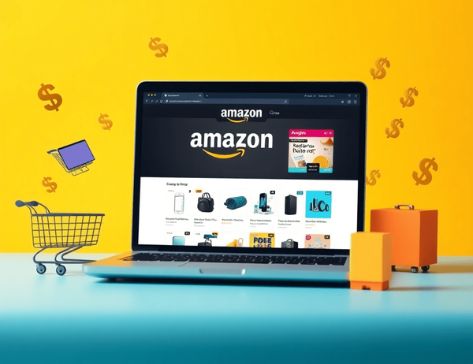
10 Proven Tips for Successful Amazon Dropshipping
Amazon dropshipping is a popular business model in the world of eCommerce. It allows sellers to list products without having to keep inventory. When a customer places an order, the seller buys the item from a third-party supplier who ships it directly to the buyer. This method reduces upfront investment and eliminates the need for inventory management, making it appealing for new entrepreneurs starting an online business.
Dropshipping on Amazon is especially important for aspiring entrepreneurs. It provides an opportunity to test the market with lower financial risk and simpler operations. Without the responsibility of managing physical stock, you can concentrate on other areas like marketing and customer service.
In this article, you will learn:
- How Amazon dropshipping works
- How to set up your account and choose products wisely
- How to build strong relationships with suppliers
- How to manage costs and increase profitability
- How to market effectively and follow policies
Start your Amazon dropshipping journey with proven strategies for success. To help you reach your financial goals, consider implementing some of these 7 surprising tips to achieve 6 figures with dropshipping.

Understanding Amazon Dropshipping
Amazon dropshipping stands out as a flexible business model where you can sell products without holding any inventory. This approach involves listing items on Amazon, and when a customer places an order, purchasing the product from a third-party supplier who directly ships it to the customer. The beauty of this system lies in its simplicity and low overhead costs.
Key Benefits Compared to Traditional Retail
- No Inventory Management: Unlike traditional retail, you don’t need to manage or store inventory. This reduces storage costs and minimizes the risk of unsold stock.
- Lower Financial Risk: With no upfront investment in large quantities of products, initial financial risk is significantly reduced. You’re only purchasing items after you’ve already made a sale.
- Ease of Entry into eCommerce: Starting a dropshipping business requires minimal capital compared to opening a physical store or maintaining large inventories.
Role of Suppliers in Order Fulfillment
Suppliers are pivotal in the dropshipping process. They handle the inventory and shipping logistics, allowing you to focus on marketing and customer service. Choosing reputable suppliers is crucial for ensuring product quality and timely delivery, which directly impacts your reputation on Amazon. Always verify credentials and establish clear communication channels to maintain strong supplier relationships.
Advantages Over Amazon FBA
While both Amazon FBA (Fulfilled by Amazon) and dropshipping offer unique benefits, dropshipping provides more flexibility. You don’t need to pay for storage space within Amazon’s fulfillment centers, making it ideal for those testing new products or markets without committing to bulk orders.
Understanding these elements helps you navigate the dropshipping landscape effectively. With reduced financial risk and operational complexity, many entrepreneurs find this model an attractive entry point into eCommerce.
Getting Started with Amazon Dropshipping
To begin your journey into Amazon dropshipping, the first step is to set up your Amazon Seller Central account. Here’s a simple guide to help you get started:
- Visit the Amazon Seller Central Page: Go to the Amazon Seller Central website and click on “Register Now.”
- Provide Basic Information: Enter your name, email, and password to create an account.
- Verification Process: Complete the verification process by providing business details such as your phone number, bank account information, and tax identity.
- Account Confirmation: Once verified, your Amazon Seller Central account will be ready for use.
Choosing between the Individual and Professional selling plans is an important decision. Each plan is designed to meet different business needs:
Individual Plan
- No monthly subscription fee
- Ideal for sellers who plan to sell fewer than 40 items per month
- Charges a $0.99 fee per item sold
- Limited access to advanced selling tools
Professional Plan
- $39.99 monthly subscription fee
- Best suited for sellers with a higher sales volume
- No per-item fee
- Access to advanced features like advertising tools, bulk listing uploads, and detailed sales reports
Selecting the right selling plan is crucial in aligning your business goals with Amazon’s platform capabilities, ensuring you start your dropshipping venture on solid footing.
Choosing Profitable Products to Sell on Amazon
Identifying profitable products is the cornerstone of a successful Amazon dropshipping business. Focusing on product selection strategies can make a significant difference in your venture’s profitability. Here are some effective approaches:
1. Research High-Demand Products
Start by analyzing current market trends to find products that are in high demand but have low competition. This balance helps maximize sales potential and minimizes direct competition.
2. Analyze Competitor Listings
Study what top sellers in your niche are offering. Look for gaps or opportunities in their offerings that you can capitalize on.
3. Customer Reviews and Feedback
Utilize customer reviews to understand consumer preferences and identify any common complaints or suggestions that can be addressed in your product selection.
To aid in this process, several tools can assist with market research and product validation:
- Jungle Scout: A comprehensive tool providing insights into sales estimates, revenue projections, and competition levels for various products.
- Helium 10: Offers a suite of tools for product research, keyword analysis, and market trends to help you make informed decisions.
- AMZScout: Useful for tracking historical data and evaluating potential product profitability based on past performance.
Leveraging these resources enables you to make data-driven decisions, ensuring your selected products align with market needs while optimizing your chances of success in the competitive realm of Amazon dropshipping.
Building Strong Supplier Relationships for Successful Dropshipping
Establishing a robust relationship with reliable suppliers is crucial for the success of your Amazon dropshipping business. Finding trustworthy suppliers can be challenging, but there are several strategies to ensure you partner with credible sources:
1. Research and Referrals
Leverage online directories like Alibaba, SaleHoo, or Worldwide Brands to find potential suppliers. Asking for referrals from industry peers can also yield reliable contacts.
2. Industry Events and Trade Shows
Attending these events provides direct access to suppliers, allowing you to build personal connections and evaluate their offerings firsthand.
Once you’ve identified potential partners, verifying their supplier credentials is essential:
1. Check Business Licenses
Ensure that the supplier has the appropriate business licenses and certifications. This step can prevent future complications related to legitimacy.
2. Request Product Samples
Before committing to bulk orders, request samples to assess product quality. This ensures that your customers receive goods that meet your standards.
3. Evaluate Communication Skills
Effective communication is key in dropshipping. A reliable supplier should provide timely responses and clear information concerning shipping times and policies.
These steps not only help in establishing a strong foundation with your suppliers but also play a vital role in maintaining quality control over the products you offer through Amazon. Building these relationships enhances your ability to deliver consistently high-quality service to your customers.
Moreover, utilizing platforms like Anstrex, which allow you to find the hottest selling dropship products and manage your store from one single platform, can further streamline your dropshipping process.
Managing Costs and Maximizing Profitability in Your Amazon Dropshipping Business
Running an Amazon dropshipping business involves a keen understanding of the various costs associated with this model. A thorough cost analysis helps you identify areas where you can maximize profitability.
1. Subscription Fees
- Individual Selling Plan: No monthly fee, but you incur a $0.99 charge per item sold.
- Professional Selling Plan: A monthly fee of $39.99, offering access to advanced selling tools and the opportunity to list an unlimited number of products.
2. Referral Fees
Amazon charges a referral fee on each sale, typically ranging from 8% to 15%, depending on the product category.
3. Fulfillment Costs
If utilizing Fulfilled by Merchant (FBM), factor in shipping costs from your supplier to the customer. Opting for Fulfilled by Amazon (FBA) incurs additional fees for storage and fulfillment services.
4. Variable Closing Fees
Specific categories, such as media items, may also attract closing fees per item sold.
5. Miscellaneous Expenses
Consider additional costs like advertising, particularly if investing in Amazon PPC campaigns, and potential returns processing fees.
Understanding these expenses ensures you maintain healthy profit margins while effectively managing your Amazon dropshipping business. Balancing these costs against your sales revenue is crucial for sustaining long-term success in the competitive eCommerce environment.
Marketing Your Products Effectively on Amazon Marketplace
Effective marketing strategies are crucial for standing out in the crowded Amazon marketplace. Utilizing a combination of SEO optimization and paid advertising, such as Amazon PPC ads, can significantly boost your product visibility and sales.
SEO Optimization
- Keyword Research: Use tools like Helium 10 or Jungle Scout to identify relevant keywords that potential customers are searching for. Incorporate these keywords into your product titles, bullet points, and descriptions to improve search rankings.
- Product Listings: Ensure your listings are informative and engaging. High-quality images, detailed descriptions, and clear bullet points can attract more clicks and conversions.
Paid Advertising
- Amazon PPC Ads: Pay-per-click advertising allows you to target specific keywords and demographics. Setting up automatic campaigns can help identify which search terms convert best, allowing you to refine manual campaigns for maximum ROI.
Other Techniques
- External Traffic: Leverage social media platforms, email marketing, or influencer collaborations to drive traffic to your Amazon listings.
- Promotions and Discounts: Offering limited-time discounts or coupons can incentivize purchases and improve your sales velocity.
By implementing these tactics, you enhance your product’s visibility on Amazon, potentially leading to increased sales and a stronger presence in the marketplace.
Providing Excellent Customer Service as an Amazon Dropshipper
Delivering exceptional customer service is a cornerstone of success in Amazon dropshipping. Responsive and efficient customer support plays a crucial role in maintaining high seller ratings, which directly impact your visibility and credibility on the platform.
Key Aspects to Consider:
- Timely Responses: Quickly addressing customer inquiries and concerns shows commitment to customer satisfaction and helps build trust. Aim to respond within 24 hours to maintain positive engagement.
- Clear Communication: Ensure all communication is clear, concise, and professional. This minimizes misunderstandings and sets accurate expectations.
- Efficient Problem Resolution: Handle returns, refunds, and disputes promptly. An effective resolution process not only satisfies customers but also prevents negative feedback.
- Proactive Updates: Keep customers informed about order status, shipping updates, or any potential delays. Transparency fosters goodwill and reduces anxiety over their purchase.
By prioritizing excellent customer service, you enhance your reputation on Amazon, leading to increased sales opportunities and higher chances of winning the coveted Buy Box.
Ensuring Compliance with Amazon Policies to Protect Your Account Health
When it comes to Amazon dropshipping, following Amazon’s rules is crucial for keeping your account in good standing. Here are the key policies you need to know:
1. Seller of Record
You must be identified as the seller on all packaging and invoices. This means that third-party branding should be absent from all deliveries.
2. Fulfillment Requirements
Ensure timely shipping and delivery as promised in your listings. Consistently meeting or exceeding these expectations helps maintain a healthy account status.
3. Customer Service Management
Handle returns, refunds, and customer inquiries efficiently. Maintaining high-quality customer service directly impacts seller ratings and thus, compliance.
4. Product Listings
Accurately describe products to avoid misleading customers, which can result in negative feedback and potential policy violations.
If you ignore these compliance issues, you risk getting your account suspended or facing penalties. It’s important to stay updated on Amazon’s policies to ensure your dropshipping business continues to thrive. By following these guidelines, you’ll not only protect your account health but also build a reputation as a trustworthy seller on the platform.
Conclusion
Starting an Amazon dropshipping business can be a game-changer for aspiring entrepreneurs. By following these proven strategies, you can tap into the huge opportunities offered by the Amazon marketplace.
Here are the key takeaways:
- Build strong relationships with your suppliers
- Manage your costs effectively
- Provide exceptional customer service
- Stay updated on Amazon’s policies to maintain your account health and reputation
With dedication and careful planning, your dropshipping business can succeed in the competitive world of e-commerce. Don’t wait any longer—it’s time to take action and start building your successful Amazon dropshipping business today!


